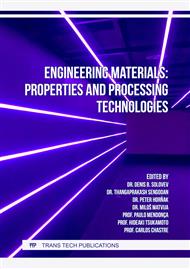[1]
I.I. Perepechko, Introduction to the physics of polymers, Moscow: Chemistry, 1978, p.312.
Google Scholar
[2]
Electrical properties of the polymer, under. ed. B.I. Sazhin: 3rd ed., L., 1986, p.224.
Google Scholar
[3]
A.R. Blythe, D. Bloor, Electrical properties of polymers, Moscow: Fizmatlit, 2008, p.376.
Google Scholar
[4]
A.A. Tartanov, Basics of processing polymeric materials, Part 1 and 2, Textbook for universities, Mines: YURGUES, 2001, p.72.
Google Scholar
[5]
V.V. Evstifeev, Electrical materials, plastics, rubbers, composites: Textbook, Omsk: Publishing house SibADI, 2009, p.36.
Google Scholar
[6]
V.N. Borodulin, Conductor, semiconductor materials: Lecture notes for the course "Electrical Materials Science", Moscow: MEI Publishing House, 1994, p.63.
Google Scholar
[7]
N.P. Bogorodsky, Electrical materials, L .: Energoatomizdat, 1985, p.304.
Google Scholar
[8]
V.V. Pasynkov, Electronic engineering materials, Moscow: Higher school, 1986, p.367.
Google Scholar
[9]
J. Shtofa, Electrotechnical materials in questions and answers, Moscow: Energoatomizdat, 1984, p.199.
Google Scholar
[10]
V.N. Borodulin, A.S. Vorobiev, V.A. Filikov and others, Ed. V.A. Filikova, Construction and electrical materials, Moscow: Higher school, 1990, p.296.
Google Scholar
[11]
High molecular weight compounds: textbook and workshop for academic bachelor's degree, ed. A. B. Zezina, Moscow: Yurayt Publishing House, p.340.
Google Scholar
[12]
V.P. Dorozhkin, Chemistry and physics of polymers: textbook, 2nd ed., Nizhnekamsk: Nizhnekamsk Institute of Chemical Technology (branch) of the Federal State Budgetary Educational Institution of Higher Professional Education "KNITU", 2013, p.240.
DOI: 10.47664/0022-9466-2021-80-3-118-122
Google Scholar
[13]
V.N. Kuleznev, V.A. Shershnev, Chemistry and Physics of Polymers, M .: Colossus, 2007, p.367.
Google Scholar
[14]
N.A. Kozlov, A.D. Mitrofanov, Physics of Polymers: Textbook, Vladimir: VlGU, 2001, p.345.
Google Scholar
[15]
A.N. Gubkin, Physics of dielectrics, Moscow: Higher school, 1971, p.272.
Google Scholar
[16]
I.S. Rez, Yu.M. Poplavko, Dielectrics, Main properties and applications in electronics, Moscow: Radio and communication, 1989, p.288.
Google Scholar
[17]
G.M. Barteniev, S. Ya. Frenkel, Physics of polymers, L.: Chemistry, 1990, p.419.
Google Scholar
[18]
A.A. Tager, Physico-chemistry of polymers, M.: Scientific world, 2007, p.573.
Google Scholar
[19]
M.B. Lachinov, General ideas about polymers, Edited by Professor V.P. Shibaev, Moscow, 2003.
Google Scholar
[20]
Workshop on chemistry and physics of polymers: textbook. ed., N.I. Avvakumova, L.A. Budarin, S.M. Divgun, ed. V.F. Kurenkov, Ed. 3rd, Moscow: Chemistry, 1995, p.256.
Google Scholar
[21]
M.I. Abdullin, and others, Viscoelastic and rheological properties of syndiotactic 1,2-polybutadiene, Journal applied chemistry. Vol. 80, 11 (2007) 1913-1917.
Google Scholar
[22]
R.G. Sayapova, Frequency and temperature dependences of dipole-segmental and dipole-group polarization in polymers and liquid crystals: Author's abstract. PhD thesis., Ufa, 2012, p.16.
Google Scholar
[23]
M.L. Williams, R.F. Landel, J.D. Ferry, The Temperature Dependence of Relaxation Mechanisms in Amorphous Polymers and Other Glass-forming Liquids, J. Amer. Chem. Soc. Vol. 77, 14 (1955) 3701-3707.
DOI: 10.1021/ja01619a008
Google Scholar
[24]
L. Solimar, D. Walsh, Per. from English ed. S.I. Baskakov, Solymar Laszlo Lectures on electrical properties of materials, Moscow: Mir, 1991, p.501.
Google Scholar
[25]
V.N. Khmelev, A.D. Oblozhkina, Materials science and technology of structural materials: A course of lectures, Alt. state tech. un-t, BTI, Biysk.: Publishing house Alt. state tech. University, 2001, p.224.
Google Scholar
[26]
Mathematical modeling, Theoretical basis, Materials for practical exercises and self-instructional work of students, Methodical instructions [Electronic resource]: educational-methodical complex, USPTU, dept. PED; comp. G.U. Yarmukhametova, Ufa: USPTU, 2018.
Google Scholar
[27]
The theory of statistics, Textbook. Ed. Gromyko G.L, Moscow: INFRA-M, 2019, p.465.
Google Scholar


